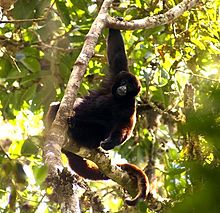
The woolly monkeys are the genus Lagothrix of New World monkeys, usually placed in the family Atelidae.

The Atelidae are one of the five families of New World monkeys now recognised. It was formerly included in the family Cebidae. Atelids are generally larger monkeys; the family includes the howler, spider, woolly, and woolly spider monkeys. They are found throughout the forested regions of Central and South America, from Mexico to northern Argentina.
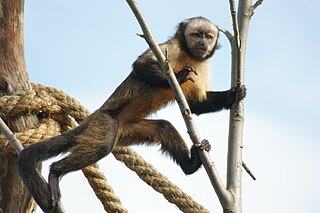
The golden-bellied capuchin, also known as the yellow-breasted or buff-headed capuchin, is a species of New World or neotropical monkey. It lives mainly in trees and are omnivorous, eating a wide variety of both plant and animals as food. Golden-bellied capuchin normal home range is in the Atlantic forest of Brazil and it is critically endangered due to forest fragmentation and habitat loss mainly due to agriculture, there are currently efforts to protect them by the local government.

The bald uakari or bald-headed uakari is a small New World monkey characterized by a very short tail; bright, crimson face; a bald head; and long coat. The bald uakari is restricted to várzea forests and other wooded habitats near water in the western Amazon of Brazil and Peru.

The common woolly monkey, brown woolly monkey, or Humboldt's woolly monkey is a woolly monkey from Colombia, Ecuador, Peru, Bolivia, Brazil, and Venezuela. It lives in groups of two to 70 individuals, usually splitting the group into smaller subgroups when active.

The white-bellied spider monkey, also known as the white-fronted or long-haired spider monkey, is an endangered species of spider monkey, a type of New World monkey. It is found in the north-western Amazon in Colombia, Ecuador, Venezuela, Peru and Brazil, ranging as far south as the lower Ucayali River and as far east as the Branco River. In the past, the Peruvian, brown and white-cheeked spider monkeys have been treated as subspecies of A. belzebuth. As presently defined, the white-bellied spider monkey is monotypic. It has a whitish belly and a pale patch on the forehead, which, despite its common name, often is orange-buff, though this might be due to dirt and other stainers. They live in groups of 20 to 40 individuals, splitting into small parties of 1 to 9 when in activity.

Prince Bernhard's titi monkey, also called the zog-zog monkey, is a species of titi monkey in the genus Plecturocebus, first described in 2002. It is named after Prince Bernhard of the Netherlands. They have varying coloration of gray, black, and agouti, with dark orange in certain regions. They are endemic to Brazil, found mostly in disturbed forest environments. While officially listed as least-concern by the International Union for the Conservation of Nature (IUCN), they may, in fact, be at-risk due to human-caused deforestation.

The Rio Mayo titi monkey is a species of titi monkey, a type of New World monkey, endemic to Peru. The Rio Mayo titi, was thought previously to have a small range of origin in the Alto Mayo valley, but research has proven that the range extends southward and reaches the Huayamba River, as well as Bajo Mayo. It had been classified as vulnerable but due to major habitat loss and restricted living space, it is now classified as Critically Endangered. In October 2012, it was included in The World's 25 Most Endangered Primates list. An increase in deforestation is leading to the decrease in available living space for this titi monkey, forcing it to live in sympatry with another species of Callicebus. Yet in some areas, such drastic deforestation has resulted in extremely high population density. The Rio Mayo titi is better adapted to moderately populated areas, thus overpopulation negatively impacts the species. The forests the Rio Mayo titi lives in are being destroyed for agricultural purposes, leaving little forest for the monkeys. They were only seen a few times and featured in museums until 2003 when more research was done on them. In order for this species to survive, their forests need to be protected to avoid overpopulation. Different conservation groups are working to help P. oenanthe survive. Neotropical Primate Conservation, Proyecto Mono Tocón and Amazónicos para la Amazonia are working in the more southern areas to protect the monkey. The Rio Mayo titi is a fairly inconspicuous creature, making observation and research difficult to obtain. Therefore, the traditional use of transect observation to monitor the monkey's population, is less effective. Instead, other methods of calculating the titi monkey's density in certain areas have been taken, such as research into the species-specific calls endemic to a certain area.

The gray woolly monkey or Geoffroy's woolly monkey is a subspecies of the common woolly monkey from South America. It is found in Bolivia, Brazil and Peru. L. l. cana gets its common name, gray woolly monkey, from its thick gray coat. Its hands, feet, face and the inside of the arms are dark in color. The gray woolly monkey has been considered endangered by IUCN since 2008. The subspecies is listed as endangered because it suffered a 50% decrease in population over the past 45 years due to deforestation and hunting.
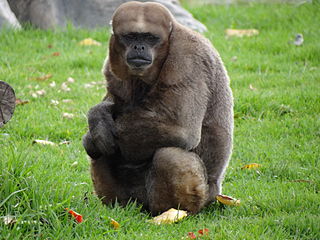
The Colombian woolly monkey is a critically endangered subspecies of the common woolly monkey from Colombia.

The silvery woolly monkey, also known as Poeppig's woolly monkey or the red woolly monkey, is a subspecies of the common woolly monkey from South America. Named after the German zoologist Eduard Friedrich Poeppig, it is found in Brazil, Ecuador and Peru.

The Peruvian spider monkey, also known as the black-faced black spider monkey, is a species of spider monkey that lives in Peru, as well as in Brazil and in Bolivia. At 60 centimetres long, they are relatively large among species of monkey, and their strong, prehensile tails can be up to 1 m (3 ft) long. Unlike many species of monkey, they have only a vestigial thumb, an adaptation which enables them to travel using brachiation. Peruvian spider monkeys live in groups of 20–30 individuals, but these groups are rarely all together simultaneously. The size and dynamics of the resulting subgroups vary with food availability and sociobehavioral activity. They prefer to eat fleshy fruit, but will change their diet in response to scarcity of ripe fruit. Individuals of this species also eat small animals, insects and leaves based on availability. Females separate from the band to give birth, typically in the fall. These females inhabit a group of core areas where resources are abundant in certain seasons. Typically, males exhibit ranging over longer distances than females, with movement of individuals enhancing the fluidity of subgroup size. Peruvian spider monkey are independent at about 10 months, with a lifespan of about 20 years.

The brown spider monkey or variegated spider monkey is a critically endangered species of spider monkey, a type of New World monkey, from forests in northern Colombia and northwestern Venezuela.

The Peruvian night monkey, also known as the Andean night monkey, is a nocturnal New World monkey endemic to northern Peru. Adults weigh around 1 kg (2.2 lb) and measure up to 50 cm (20 in) in length. Its colour is grey to light brown with characteristic black and white markings on the face. The chest, belly and upper arms are orange tinged, however, to a lesser extent then Aotus nigriceps.
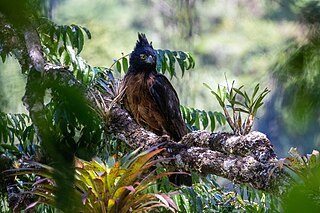
The black-and-chestnut eagle is a large South American species of bird of prey in the family Accipitridae. It is sometimes called Isidor's eagle. It is often placed in the monotypic genus Oroaetus. However, recent genetic testing indicates that this species is fairly closely related to Spizaetus species and thus the species should be included in that genus. The black-and-chestnut eagle is a typical forest raptor, hunting primarily small to medium-sized mammals and birds and constructing a large nest in a tall tree. Unfortunately, the twin causes of habitat destruction and persecution, justified or not as an occasional poultry killer, have caused strong population declines and the black-and-chestnut eagle is considered to be an Endangered species by the IUCN.

The Mexican howler is a subspecies of the mantled howler, A. palliata. This subspecies is found predominantly in forests between south eastern Mexico and north eastern Peru. Typical of its species, the Mexican howler monkey has a prehensile tail, a deep jaw, and a large pharynx which it uses to make characteristically deep and resonating howls. Mantled howler monkeys are known for forming unusually large cohorts averaging 14 members and sometimes extending to 40 members.

The brown-headed spider monkey is a critically endangered subspecies of the black-headed spider monkey, a type of New World monkey, found in northwestern Ecuador.
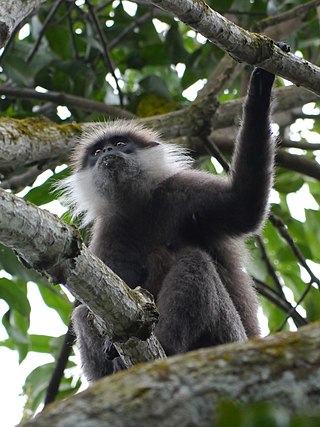
The western purple-faced langur, also known as the north lowland wetzone purple-faced langur, is a subspecies of purple-faced langur endemic to Sri Lanka. It lives in the wet zone in western Sri Lanka around the former capital city of Colombo. This subspecies are known to live in tropical rainforest, specifically in an area of Sri Lanka, where it is noted to rain two times more compared to the neighboring region. The subspecies is generally gray-brown with lighter whiskers, a gray rump patch, and dark forearms and legs. These monkeys also have dark brown or black, hairless faces. Their hands and feet are also hairless. When infants, their fur is medium brown to light gray, however it changes to their darker adult colors at between 12 and 16 weeks old. Typical length is between 48 and 67 centimetres excluding tail, with a 59 to 85 centimetres tail. On average, males weigh 8.5 kilograms (19 lb) and females weigh 7.8 kilograms (17 lb). Their average life span is about 26 years if the monkey was held in captivity. Due to their leafy diet, the western purple-faced langur back teeth, include high crowns and pointed cusps to make eating through greenery simpler. They also developed a digestive system that would allow them to break down cellulose in the leaves they eat. Although, leaves are their primary source of food, they also eat fruits and flowers. Female langurs hold a pregnancy for 195–210 days, and after the birth the offsprings are taken closely cared for by the mother until they are about 12–20 weeks old.

The Peruvian Yungas comprise a tropical and subtropical moist broadleaf forest ecoregion in Peru.
This is My Earth (TiME) is a non-profit organization dedicated to preserving biodiversity by using crowdsourcing to purchase lands in biodiversity hotspots.
